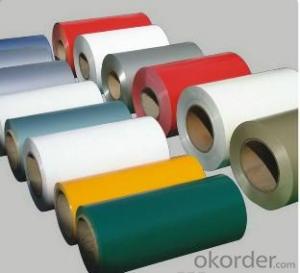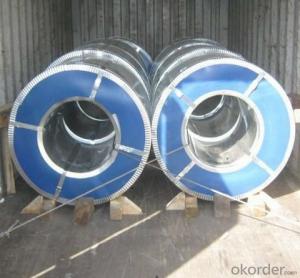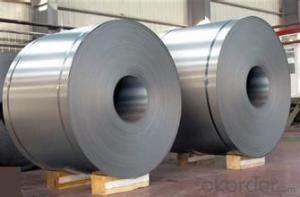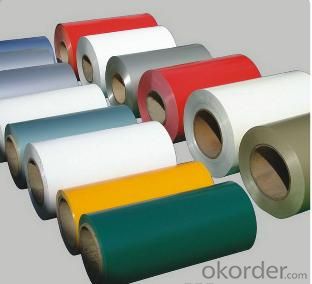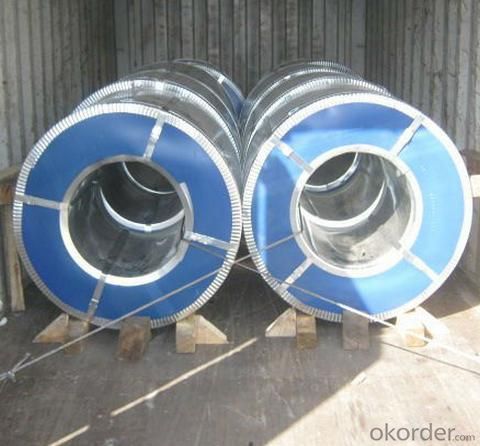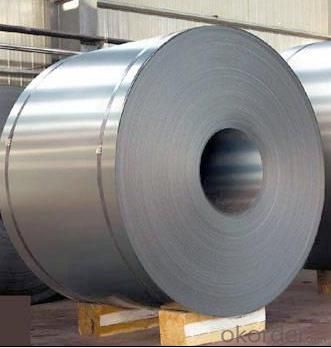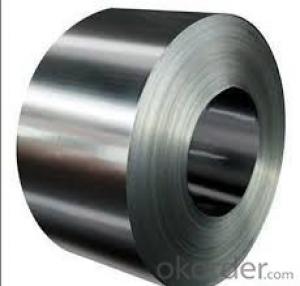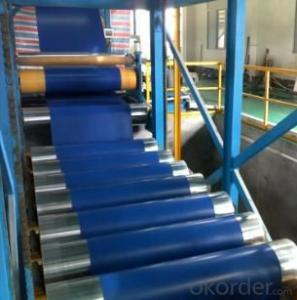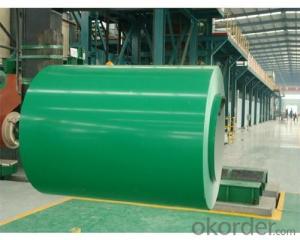Colored Coated Galvalume Steel Coils for Building
- Loading Port:
- Shanghai
- Payment Terms:
- TT OR LC
- Min Order Qty:
- 25 m.t.
- Supply Capability:
- 10000 m.t./month
OKorder Service Pledge
OKorder Financial Service
You Might Also Like
| Standard: | AISI,ASTM,GB,JIS | Grade: | CGCC CGCH | Thickness: | 0.17-0.6mm |
| Place of Origin: | China (Mainland) | Brand Name: | Model Number: | GL-001 | |
| Type: | Steel Coil | Technique: | Cold Rolled | Surface Treatment: | Coated |
| Application: | Container Plate | Special Use: | High-strength Steel Plate | Width: | 750-1250mm |
| Length: | C | certificate: | SGS,BV,ISO | usage: | building roofing material |
| coil weight: | 3-7 ton | coil ID: | 508mm | base metal: | hot rolled steel coil |
Packaging & Delivery
| Packaging Detail: | mills standard export seaworthy packing or according to the customers' requirements |
| Delivery Detail: | 30days |
Galvalume Steel Coils/Coil
Product advantages:
A.high strength
B.strong soundess
C.well rainproof performance
D.continuous rolling
E.good corrosion resistance
F.easy to install and remove
Quality guarantee:
our company attaches importance to quality management and assurance,it is equipped with sound testing means and has passed the certification of ISO9001 Quality Management System and SGS,BV verification
Deiverse products
With world high-quality galvanized,aluminum and zinc coated and cold-rolled steel coils as base materials.
- Q: What are some of the greatest steel guitar songs in the history of country music. Western swing applies also.
- Bob okorder /
- Q: What are the safety precautions to be taken while handling steel coils?
- When handling steel coils, several safety precautions should be followed to minimize accidents and injuries. Some of the key safety measures include: 1. Personal Protective Equipment (PPE): Wearing appropriate PPE, such as safety gloves, steel-toed boots, and protective eyewear, is essential to protect against potential hazards like cuts, impacts, and eye injuries. 2. Proper Lifting Techniques: Using correct lifting techniques, such as bending the knees and using leg muscles instead of the back, helps prevent strains and back injuries. It is also important to seek assistance or use lifting equipment when dealing with heavy coils. 3. Secure Storage and Handling: Coils should be stored in a stable and secure manner, ensuring they are properly stacked and restrained to prevent them from tipping or falling. Adequate space should be provided between stacks to allow safe movement around them. 4. Inspection and Maintenance: Regularly inspecting coils for any defects, such as sharp edges, loose straps, or damaged packaging, helps prevent accidents. Damaged coils should be repaired or replaced, and any loose materials or debris should be removed. 5. Proper Handling Equipment: Using appropriate handling equipment, such as coil lifters or forklifts, ensures safe transport and manipulation of steel coils. Operators should be trained in the correct use of such equipment to minimize the risk of accidents. 6. Communication and Signage: Clear communication among workers and proper signage indicating potential hazards, load capacities, and designated walkways can help prevent accidents and ensure a safe working environment. By following these safety precautions, the risk of accidents, injuries, and damage associated with handling steel coils can be significantly reduced.
- Q: What are the different types of steel coil grades and specifications?
- There are several different types of steel coil grades and specifications, including hot rolled, cold rolled, galvanized, and stainless steel coils. Each type has its own unique properties and uses. Hot rolled coils are produced at high temperatures and are commonly used in construction and manufacturing applications. Cold rolled coils are produced at lower temperatures and have a smoother finish, making them suitable for applications that require a higher level of precision. Galvanized coils are coated with a layer of zinc to protect against corrosion, while stainless steel coils contain a high percentage of chromium for added durability and resistance to corrosion. Overall, the choice of steel coil grade and specification depends on the specific requirements of the project or application.
- Q: How are steel coils used in the production of storage containers?
- Steel coils are an essential component in the production of storage containers. These coils, which are made from high-quality steel, are used to create the walls, floors, and roofs of the containers. The process begins with uncoiling the steel coil and passing it through a series of machines that cut and shape the steel into the desired dimensions. The steel is then formed into panels that are welded or riveted together to create the container's structure. Steel coils are an ideal material for storage containers due to their strength, durability, and resistance to corrosion. They provide a sturdy framework that can withstand heavy loads and harsh environmental conditions. Additionally, the coils can be easily molded and customized to meet specific size and shape requirements. Once the container's structure is complete, it is usually coated with a protective layer of paint or other coatings to further enhance its durability and resistance to weather elements. This ensures that the container can withstand exposure to moisture, UV rays, and other external factors that may cause deterioration. Overall, steel coils play a crucial role in the production of storage containers by providing the necessary strength and durability required to store and transport a wide range of goods and materials safely.
- Q: How are steel coils used in the production of automotive stampings?
- Steel coils are an essential component in the production of automotive stampings. These coils are typically made from high-quality steel and are cut into specific widths and lengths to meet the requirements of automotive manufacturers. The first step in using steel coils for automotive stampings is to uncoil the steel. This is done using a machine called a decoiler, which unwinds the coil and feeds it into the stamping machine. The decoiler ensures a continuous supply of steel for the stamping process. Once the steel coil is unwound, it is fed into the stamping machine, which is equipped with a die that shapes the steel into the desired automotive component. The die is designed to create precise and complex shapes, such as car body panels, doors, fenders, or structural components. The stamping machine applies force to the steel coil, pressing it against the die and forming it into the desired shape. The high-quality steel used in the coils ensures that the stamped components have the necessary strength and durability required for automotive applications. After the stamping process, the stamped components are inspected for quality and precision. Any imperfections or defects are identified and corrected before the components are sent for further processing, such as painting, welding, or assembly. Overall, steel coils play a crucial role in the production of automotive stampings. They provide a continuous supply of high-quality steel, which is shaped into precise and durable automotive components. The use of steel coils ensures that the automotive stampings meet the required standards for strength, durability, and precision.
- Q: How are steel coils used in the manufacturing of construction reinforcement bars?
- Steel coils are used in the manufacturing of construction reinforcement bars by being processed and shaped into the desired size and shape. The coils are first uncoiled and straightened, then cut into shorter lengths. These shorter lengths are then bent and twisted to create the necessary patterns and shapes, which provide enhanced strength and durability to the reinforcement bars.
- Q: What is the maximum weight capacity for a steel coil lifting device?
- The maximum weight capacity for a steel coil lifting device can vary depending on its design and specifications. It is important to refer to the manufacturer's guidelines and specifications to determine the specific weight capacity for the lifting device in question.
- Q: Monopolistic competition means all of their products are identical like things in supermarket like milk. There are no high barriers to entry. Oil and steel are all same in all industries.
- While oil and steel may seem to be all the same, they are really not. There are many different grades of crude oil and many different types of steel.
- Q: I know that carbon steels and alloy steels are different but are carbon steels still alloys?Thanks!
- Carbon steels are alloys. This is evident in the carbon-iron phase diagram:
- Q: How are steel coils coated to prevent rust and corrosion?
- Steel coils are coated to prevent rust and corrosion through a process called galvanization. This involves immersing the coils in a bath of molten zinc, which forms a protective layer on the steel surface. This zinc coating acts as a barrier, preventing oxygen and moisture from coming into contact with the steel, thus reducing the risk of rust and corrosion.
Send your message to us
Colored Coated Galvalume Steel Coils for Building
- Loading Port:
- Shanghai
- Payment Terms:
- TT OR LC
- Min Order Qty:
- 25 m.t.
- Supply Capability:
- 10000 m.t./month
OKorder Service Pledge
OKorder Financial Service
Similar products
Hot products
Hot Searches
Related keywords
